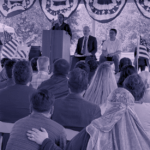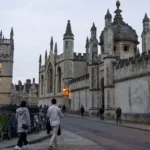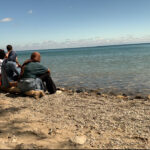An Armenian cemetery in Üsküdar, on the Asian side of Istanbul. Like Jewish cemeteries across Central and Eastern Europe, many Armenian cemeteries in Turkey have been left neglected or destroyed. (Photo: John Klopotowski)
Two Junes ago, I spent my birthday at the house that my grandmother—medzmair, in Armenian—lived in as a young girl in Istanbul. The old ivory building, just a block off one of Istanbul’s busiest streets, looks so renovated that I doubt she would recognize it today. She left the city in the early days of the Turkish Republic, a few years after her father was killed in the Armenian Genocide.
I stood in front of her old house unbothered by anyone on the street. I thought I could summon enough courage to knock on the door and ask someone to let me in. Once making up 20% of the city’s population, Armenians now make up 0.3% of the city of 16 million. The remaining bunches of Armenians live inconspicuously and would not recommend knocking on a stranger’s house to announce that their Armenian grandparent once lived where a Turk does now. It became clearer to me, with every passing second I stood in the street, that I would not summon the courage to knock.
As the brutality that Medzmair experienced in this house all those years ago loitered, my fear turned into anger. The memory of violence pollutes the city’s air like plumes of stale tobacco, ebbing and flowing with the zephyrs off the Bosphorus. It’s suffocating. Turkey, to this day, denies the Genocide and criminally prosecutes those who speak about it. More than 150 other countries’ governments contribute to its erasure by failing to formally recognize it.
Each state has its own justification for denial, and each one is worth studying. Recently, as Israel’s blockade of Gaza continues along with its bombardment and invasion of the Strip—and as more organizations around the world determine that the country’s assault on Palestinian life constitutes a genocide—I’ve focused on Israel’s orientation toward the Armenian Genocide, thinking that the state’s stance on history might illuminate principles that guide it and some of its advocates today.
In 1982, the First International Conference on the Holocaust and Genocide was held in Tel Aviv. After one of the organizers of the event, Israel Charny, invited a number of academics to discuss the Armenian Genocide, the Israeli Foreign Ministry demanded Charny remove the Armenian Genocide from the conference’s itinerary and bar Armenian academics from speaking.
Plans unraveled. Administrators of Yad Vashem, the country’s official Holocaust memorial, announced that it would no longer host the opening ceremony; Elie Wiesel resigned as the president of the conference; Tel Aviv University and Hunter College withdrew their sponsorship. Charny decided to go on, and attendance was cut in half. Before the conference, Wiesel apparently told Charny “not to use genocide in plural.” For Wiesel, the Armenian Genocide is not comparable to the Holocaust.
The bottom floor of my grandmother’s home is now occupied by an old, mustachioed chef, a köfteci, who contentedly stands in the corner, grilling freshly ground and spiced meat. Next to his grill lies a pile of bright vegetables: red tomatoes, purple onions, green peppers. He spends hours swiftly filling these into a French roll with a couple pieces of meat when someone asks for a sandviç.
To spite my fearful anger, I puttered up to the chef as he piled veggies into a roll. He looked friendly. On a whim I told him that my grandmother used to live in the building. Amazed—or in disbelief, I couldn’t really tell—he welcomed me and asked how long ago they were here. “A while,” I said. “A long time ago.” I asked him who currently owns the building, and he told me a name that I couldn’t remember. It wasn’t my grandmother’s. He then asked me our name, so I told him. “Giragosian.”
He repeated it back slowly, to confirm he heard correctly, with an emphasis on that last syllable, “Gira…gos…yan.” The overwhelming majority of Armenian names end in –ian.
“That’s right,” I said.
He asked me if I wanted the owner’s cell phone number, and I shook my head no. “Tamam,” he said. Okay. Before leaving, he reassured me that I could come back anytime. I thanked him. He nodded at me, and then he smiled a soft, gentle smile and offered me a free sandwich. That was all he could do. I went home and enjoyed the sandwich and cried.
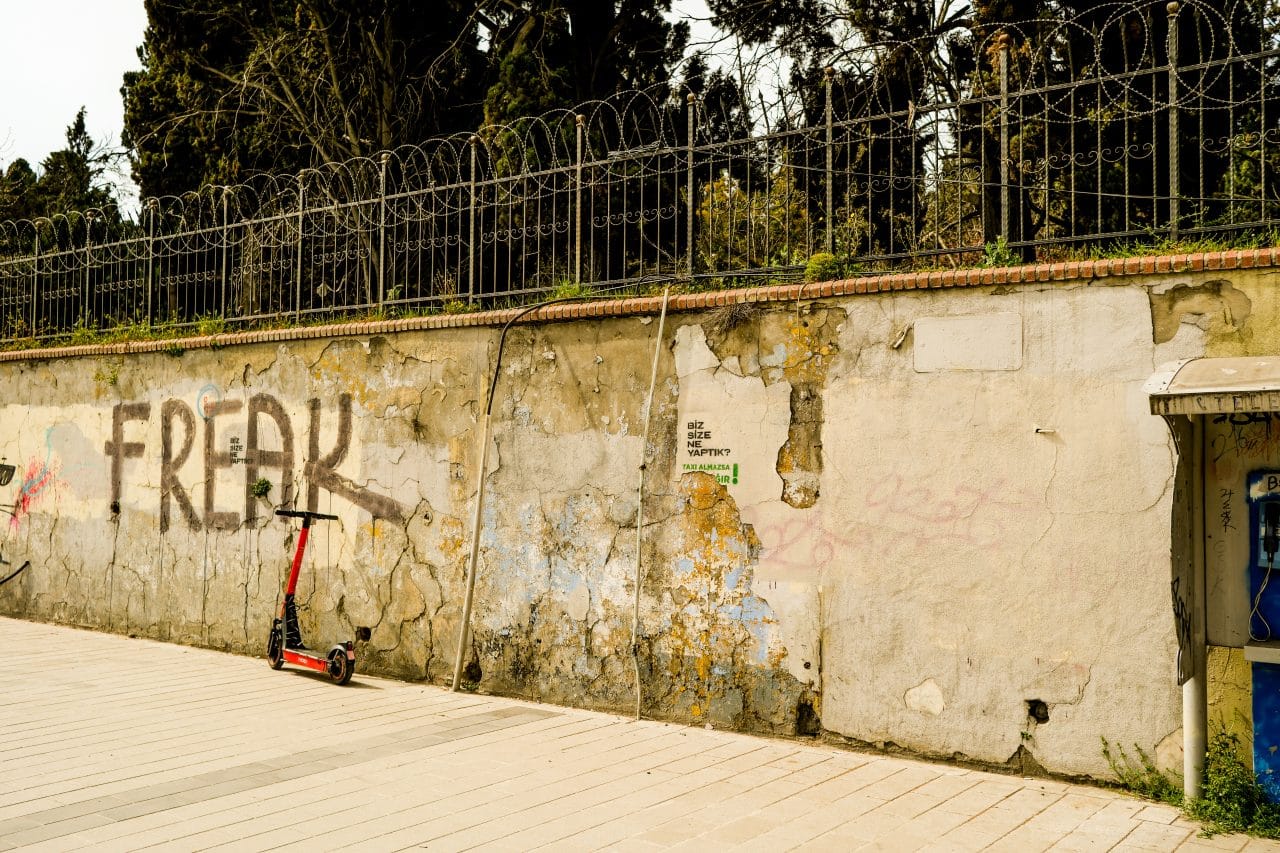
Outside the walls of an Armenian cemetery in the densely populated district of Şişli, on the city’s European side. The cemetery, which holds victims of the Genocide, bears few markings. Visitors are closely monitored. (Photo: John Klopotowski)
“Crime against humanity” entered international lexicons in May 1915, when France, Russia, and the United Kingdom issued the Triple Entente declaration. World War I had just started, and so had the systematic and catastrophic Ottoman massacres of Armenians and other ethnic and religious minorities in Asia Minor.
Given that the Ottomans fought against the Allied powers in the Great War, it was politically uncomplicated for these three empires to condemn the mass execution of Armenians, which would eventually become known as a genocide. In fact, Raphael Lemkin, the man credited with the idea of ‘genocide,’ had previously studied the Armenian massacres as a law student in Lvov decades before theorizing about genocide. At the time, Lemkin, a European Jew whose family would perish some decades later in the Holocaust, thought that the crime’s perpetrators—the Young Turks—ought to be tried for their crimes in some international venue.
Weeks after I visited Medzmair’s house, I walked to my final Turkish lesson of the summer. Toward the end of my walk, I took a small, curvy alley that connected me to a big street only a block from my class.
In all my time walking that summer, I had never seen a streetcar come up or down the tracks that ran through this alley. I don’t remember what I was doing as I was walking that morning—maybe looking at my phone, or just staring down and watching my legs come in and out of view.
Unaware, I began rounding its sharp curve and heard a shrill scream. I recognized it as jumbled Turkish but was too tired to translate before it repeated itself in my head. I realized one of the words cried out was “tram.”
The streetcar I had never seen was coming around the curve, and I was in the middle of the narrow alley. I paused a moment and whispered an expletive as the head of the tram peeked around the curve.
A flash of blue grabbed my arm and pulled me onto the steps of an old apartment building, seconds before the tram hurled itself around the curve and disappeared down the alley. The person who protected me was an older woman wearing a light blue niqab that bared her brown, concerned eyes.
Embarrassed, I thanked her. She replied with a sigh and click of the tongue, by which she meant: I’m relieved that you’re fine, but you really should be more careful. She followed the gentle scolding with a simple plea, “Dikkat et evladım!”—Pay attention my boy! I quickly nodded and went on to class. I spent the remainder of my walk wondering whether she would have protected me if she knew that I am Armenian, and resenting that I even thought of the question.
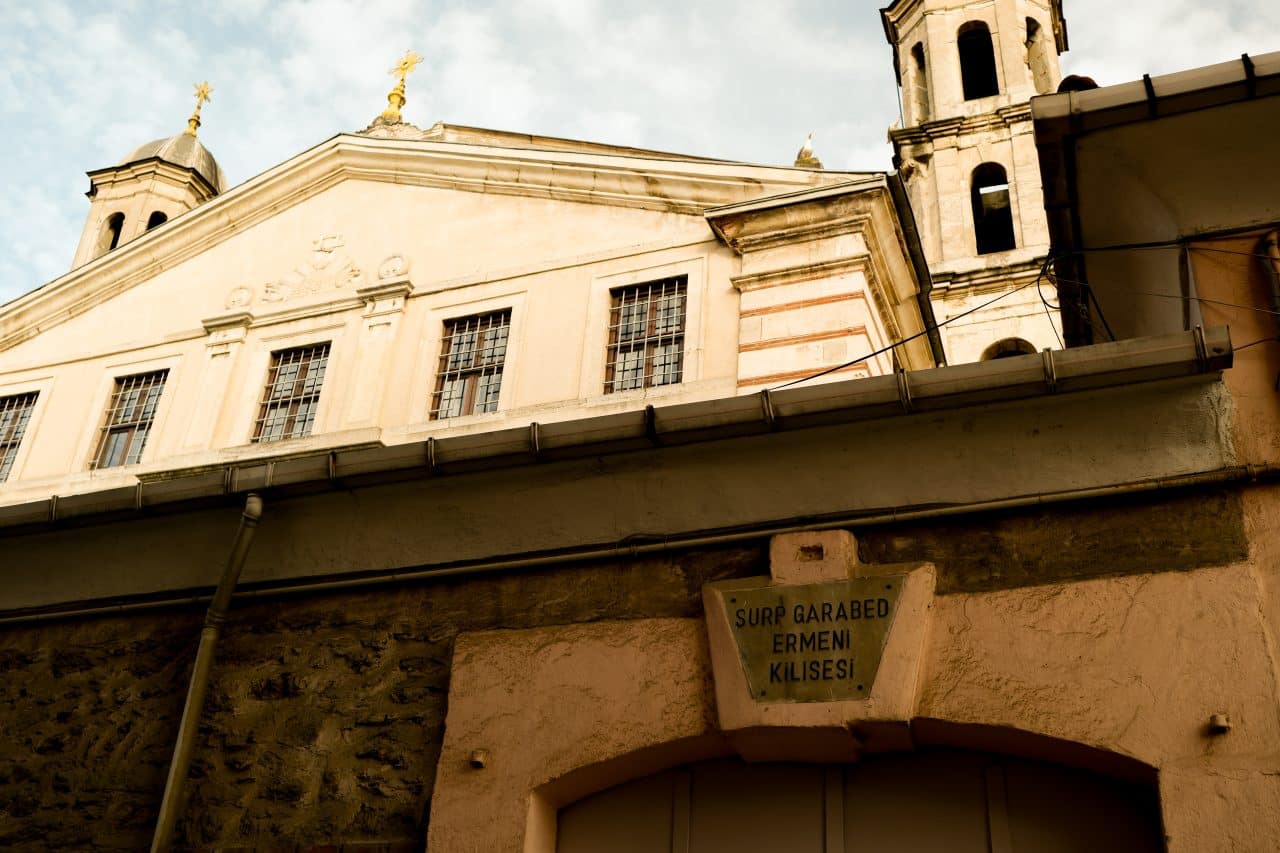
Like most Armenian churches in the city, Surp Garabed in Üsküdar lies on an alley, beyond high walls and big metal doors. (Photo: John Klopotowski)
Many university students adopt high-minded positions while on campus and throw them out as soon as they toss their mortarboards in the air during commencement. Not Raphael Lemkin. A few decades after law school, Lemkin wrote his book Axis Rule in Occupied Europe, which lays out his theory of the case against Hitler and the Holocaust’s engineers and executors. At this point, the horror that the Nazis were inflicting upon the Jews of Europe had no specific name. Lemkin called it “genocide.” His definition for genocide was simply the destruction of a group of people or nation; he combined the Greek “genos,” meaning tribe, or nation, with the Latin combining form, “-cide,” denoting an act of killing. He used the Ottomans’ slaughter of Armenians as a prime example of this. But Raphael Lemkin’s goal, in creating the term genocide, was to prevent “future Hitlers,” and to provide the “prevention and punishment in time of peace and war” for genocide around the world. To do so, Lemkin thought, we must first consider history—like what happened to the Armenians—dispassionately and honestly.
At the end of the day, my Turkish teacher, Efendi, took me out to lunch not far from Medzmair’s old building. I had just spent several weeks with Efendi, seeing him six days a week for eight hours. I was headed back to California that evening.
As we ate kebabs and drank ayran hours before I left Efendi, I mentioned my trip to Medzmair’s old house. He was shocked when I told him that I used the name Giragosian. My family, for a time, had adopted a Turkish last name to stay inconspicuous; Efendi said I should have used that name.
He asked me whether the man gave me any trouble. “No,” I said. “He offered me a sandwich for free.” Efendi let out a quick sigh of relief before he, like the woman from the morning, clicked his tongue a few times and shook his head at me, by which he meant: I’m relieved that you’re fine, but you really should be more careful.
For weeks, he had quipped to me, always in a low whisper even if we sat alone in a locked classroom, that “traditional Ottoman food is actually Armenian.” He made the claim so frequently that it almost became a bit between us, a funny-not-so-funny running joke. When I would respond to him, “Really, Efendi?” his dimples would drop, dragging his smile down into something more po-faced.
“Of course,” he’d say emphatically, still in a whisper. “Armenians are the original Anatolian people.” Then he would tell me for the nth time not to repeat what he said to anyone in public. Or over text. Or in an email. Or on a secure voice call to the US.
He has reason to be fearful. Many Turks have been prosecuted for speaking publicly about the Genocide, and the country’s most prominent Armenian-Turkish intellectual, the journalist Hrant Dink, was murdered in 2007. It’s unclear how involved the state was with his death.
We walked out of the restaurant after lunch and Efendi grabbed my arm, his clamp both unyielding and affectionate. A few days prior, he had called my mother to tell her that he considered me his second son. “He meant it,” she later relayed to me.
Unlike many of his countrymen, Efendi has opinions on the Armenian Genocide not because the idea of it offends his Turkishness, but rather because the fact of it offends his humanity. Efendi’s dignity is degraded by the impunity that his country enjoys. Indeed, around the world, there are people like Efendi whose everyday movement and speech is restricted by states and media for the sake of preserving a country’s lies.
When Amnesty International issued a 296-page report labeling Israeli actions in Gaza a genocide, the Anti-Defamation League called the report “blood libel.” Israel’s Foreign Ministry replied: “The deplorable and fanatical organization Amnesty International has once again produced a fabricated report that is entirely false and based on lies.”
This is the Ministry that torpedoed the 1982 Holocaust conference due to the Armenian speakers. Charny, the organizer of the 1982 conference, later wrote that the main reason his country did not tolerate Armenian speakers was to keep the Holocaust “at the ultimate untouchable apex of a hierarchy of genocidal suffering”; to keep the Holocaust “the greatest evil ever seen in human history.”
The Hebrew word for the Holocaust, “shoah,” means catastrophe. The Arabic word for the forced removal of nearly one million Palestinians in 1948, “al-nakba,” means catastrophe. One of the Armenian words for the Armenian Genocide, “aghet,” means catastrophe. Raphael Lemkin understood at the time of the Armenian Genocide that our ability to prevent future suffering—indeed, genocides—relies most of all on international recognition. For that reason, these catastrophes cannot be ranked.
Lemkin knew then, as Efendi knows now, that the only way to invalidate perpetrators’ denials is to call these crimes what they are: catastrophes so great that they leave the rest of humanity under threat. When these crimes are not called what they are—indeed, when they are denied—citizens who know about history, like Efendi, fear speaking out; citizens who do speak out, like Hrant Dink, are killed.
The afternoon that I left Istanbul, Efendi thought over his goodbye message as we stood in the street. His grip on my arm remained firm as he formulated his ideas.
“When you get home to the U.S.,” he paused briefly, “tell your mother that some of us here know what happened to your family. This is very important,” he said slowly.
“Some of us know the truth.”
I was within a half mile of Medzmair’s home, but Efendi had taken me to a different country. It was a version of Turkey that existed in a different time and place than the one I had lived in for the summer.
Efendi’s Turkey recognizes that crimes like the Armenian Genocide or the Holocaust or the Genocide in Gaza are crimes so vile and hideous that they offend and threaten the dignity of not only Armenian life, Jewish life, or Palestinian life; they threaten human life—a century ago and today alike.
He let go of my arm and smiled. I smiled right back.






